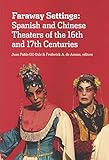Faraway Settings : Spanish and Chinese Theaters of the 16th and 17th Centuries / Juan Pablo Gil-Osle, Frederick A. de Armas.
Material type: TextPublisher: Frankfurt am Main : Vervuert Verlagsgesellschaft, [2020]Copyright date: ©2019Description: 1 online resource (266 p.)Content type:
TextPublisher: Frankfurt am Main : Vervuert Verlagsgesellschaft, [2020]Copyright date: ©2019Description: 1 online resource (266 p.)Content type: - 9788491920922
- 9783964568922
- online - DeGruyter
| Item type | Current library | Call number | URL | Status | Notes | Barcode | |
|---|---|---|---|---|---|---|---|
 eBook
eBook
|
Biblioteca "Angelicum" Pont. Univ. S.Tommaso d'Aquino Nuvola online | online - DeGruyter (Browse shelf(Opens below)) | Online access | Not for loan (Accesso limitato) | Accesso per gli utenti autorizzati / Access for authorized users | (dgr)9783964568922 |
Frontmatter -- Table of contents -- Preface -- Theatrical Origins -- Jongleuresque Origins -- Spain Learning about Chinese Theater (Miguel de Luarca’s Verdadera relación de la grandeza del Reino de China) -- Oneiric Excesses and Theatricality -- Painting Emotions and Dreams (Tang Xianzu’s Peony Pavilion and Lope de Vega’s La quinta de Florencia) -- Global Climate and Emotions -- Emotion, Object, and Space (Tang Xianzu’s Peony Pavilion and Pedro Calderón de la Barca’s La vida es sueño) -- Global Stagings -- Picaresque Theater (Miguel de Cervantes’ Pedro de Urdemalas, directed by Alejandro González Puche and Ma Zhenghong) -- Theatrical Characters (Pedro Calderón de la Barca’s El astrólogo fingido, directed by Alejandro González Puche and Ma Zhenghong) -- Audience Reception (Pedro Calderón de la Barca’s El astrólogo fingido, directed by Alejandro González Puche and Ma Zhenghong) -- From Novel and Theater (Pedro Calderón de la Barca, La vida es sueño, directed by Chen Kaixian) -- Sinosphere -- Christian sacred plays and Nō Style -- Depicting Japan: Lope de Vega and Los primeros mártires del Japón -- Contributors -- Index -- También en Iberoamericana/Vervuert
restricted access online access with authorization star
http://purl.org/coar/access_right/c_16ec
A comparative study of Ming and Iberian theaters has never been attempted. Thus, this book aims to provide the reader with a series of different approaches. First, through a comparison of specific works by Spanish and Chinese playwrights during the Ming and Habsburg periods, we aim to show that at times certain commonalities are in reality spaces fraught with misunderstanding. A melancholic character in Spain would not be the same as a melancholic figure in Chinese theater. A particular plant or flower had completely different symbolic meanings. However, it is curious to note how certain character types in both theaters resemble each other; and how the interaction between actors and audience would show clear parallels. At the same time, this is a book that also finds the thrill of correspondences and affinities as they are recovered through modern staging, climate change, universality of emotions, representations of friendship, folk characters, metaphors and dreams.
Mode of access: Internet via World Wide Web.
In Spanish, Castilian.
Description based on online resource; title from PDF title page (publisher's Web site, viewed 25. Jun 2024)


